Fredrik Prost’s journey in posture is a poignant one. Restoring one’s natural architecture is a return home for anyone - a return to one’s personal past, ancestral past, and genetic past. For Fredrik, it’s additionally a return to his living Sami relatives and those alive in his memory.
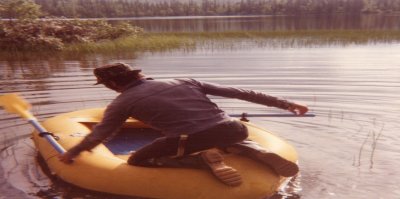
Fredrik's late father, Sigurd, on Lake Vettasjarvi in the very north of Sweden.
The Sami are an indigenous group of reindeer herders living in Norway, Sweden, Finland and Russia.

The Sami use sleds, dogs, and snowmobiles to herd their reindeer
Fredrik is a traditional Sami handicraftsman working with reindeer antler, metal, and wood.
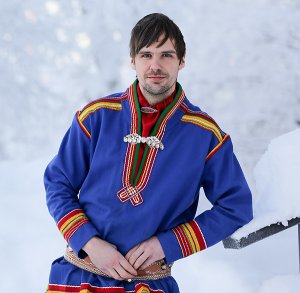
Fredrik Prost, traditional Sami handicraftsman
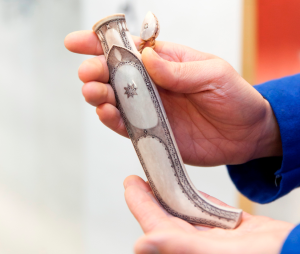
Engraved knife + sheath made from antler, metal
Being of a younger generation and between a traditional lifestyle and a modern one, his working posture included hunching over his work. As a result he had developed upper back pain for which conservative treatment failed to give him relief. He discovered my book, and the pictures and philosophy resonated for him - I was describing things he had seen with his own eyes. So he traveled from his home and workshop in Kiruna, Northern Sweden to attend my June 2014 Gokhale Method Foundations course in Bonn, Germany.
Fredrik was an unusual student - he hip-hinges naturally, his pelvis anteverts, and he has a quiet dignity about him.
During the breaks between classes he shared an anthropology book with me that showed photographs of his grandparents and grand uncles, tallstanding with open chests, hip-hinging with flat backs, and emanating the self-possession and poise that is so characteristic of indigenous people.
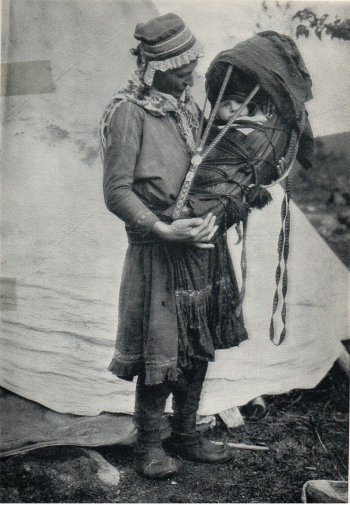
Fredrik's great grandmother Inga-Marja Seva with his grandmother
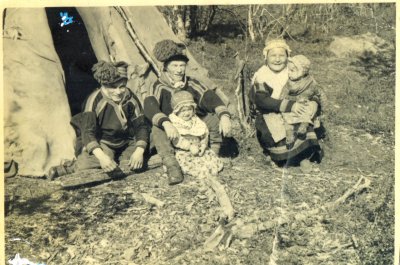
The baby on the right is Fredrik's mother, Ingrid
I was fascinated and we kept in touch through regular Skype meetings. I asked questions about his family, community and the Sami people, getting more intrigued in every conversation. I learned about the kind of tepee his mother was born and raised in (in temperatures that dropped below -55 degrees F), what part of a reindeer’s fur is warmest, how he forges steel for his carved knives, how the Sami dogs know that to attack a human would be their last mistake,... Sensing my interest, Fredrik asked if I would like to visit their community for the marking of the reindeer calves in July (joining a moose hunt in the Fall or counting the calves in the winter might be a tough entry into the culture, he reckoned). And so it has come to be… this summer I will travel to Sapmiland in Northern Sweden for this adventure.
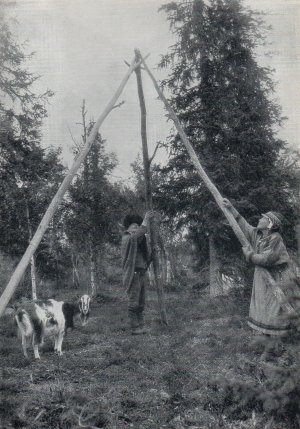
Fredrik's great grandparents Itsa and Susanna Prost
I have several goals for this visit. Of course, I will learn about traditional body ways and movement. I also hope to taste what it means to be rooted in nature, to yoik (traditional singing/chanting) the wind and be the wind,
Note added July 29,2015: Fredrik informed me that videos of this type, created by the Finnish government to promote the tourist industry, is not authentic and is, understandably, problematic for the Sami.
and to live communally without ownership of the land. I want to see and experience what it means when logging companies and mining interests threaten one’s livelihood.
And I would like to figure out how best I can give back to this and other communities from whom I have gotten so much. These people hold alive a treasure for those of us in more modern settings - I know this to be true for musculoskeletal health; I suspect it is also true for other aspects of life.
I will keep you posted as this unfolds.
In a couple of weeks Fredrik departs for Jokkmokk, the Sami winter market held annually since 1605. He will be displaying his art.
Here is a link to his website for those of you who are interested.

Box (birch and reindeer antler)
Best,
Esther
Join us in an upcoming Free Workshop (online or in person).
Find a Foundations Course in your area to get the full training on the Gokhale Method!
We also offer in person or online Initial Consultations with any of our qualified Gokhale Method teachers.


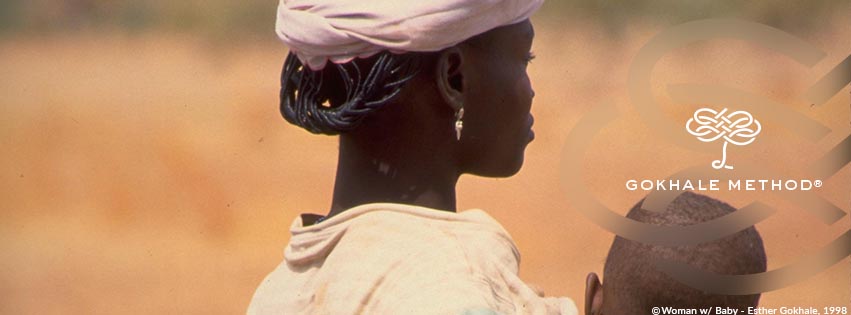
Comments
This sounds so very
This sounds so very interesting! I can't wait to see the results of your adventure! ^_^
Very interested to hear more
Very interested to hear more about this. I'd be interested to see pictures of and learn about anything having to do with milking the reindeer, what they do with the milk i.e. what kinds of cheeses or other dairy products they might produce. Also, any traditional foods and their preparation.
From my notes in talking with
From my notes in talking with Fredrik: "I have a picture of my mother milking a reindeer - not tied to anything. Just standing there. I'ts a picture from the 70’s. They were tamer before. Herding was a completely different matter. They milked the reindeer everyday during summer. I don’t think anyone milks them today. I've heard of someone doing it in Norway. It stopped when I was fairly small. I’d like to try it. I have this idea of having a small herd to milk and make cheese. That’s what they would do - make round cheeses. To put in coffee or just like that. I would make some sort of living maybe. I would have to abandon the city and live in a small town..."
This is the picture Fredrik mentioned of his mother Ingrid milking a reindeer (in the 70's):
This is a picture of a woman who helped Fredrik's grandmother milk reindeer. The physical intimacy between the woman and the reindeer is so striking to me...
I would love to catch up with
I would love to catch up with news of this wonderful adventure after your visit to Sweden. This is a very inspirational story!
"These people hold alive a
"These people hold alive a treasure for those of us in more modern settings - I know this to be true for musculoskeletal health; I suspect it is also true for other aspects of life."
I couldn't agree more. Recording the enthnographic details of traditional societies is work that benefits us all. It's unfortunate that so many of these cultures are already gone or fast fading. I don't regret most change in life, but I am saddened by the losses. We need this record of our shared human history in order to understand who we are, and to decide intelligently where we are going as a species. Any records you bring back and awareness you are able to raise will be a welcome and treasured addition to our knowledge and I look forward to learning more about it.
Good luck on your adventures, Esther!
Estheryou said he has upper
Esther
you said he has upper back pain
i have to know what he is doing to help it!!!!!
emily
Be sure to join our (free)
Be sure to join our (free) online workshop on Fredrik's Top Tips on Feb 28, 2015 at 10 am PT through YouTube broadcast - sign up through the newsletter and we will keep you reminded, informed of tech requirements (not daunting, I promise), etc. I'm hoping Fredrik will be able to join us through Skype but as you can imagine, if you help with reindeer herding (as he does), your life is not always predictable...in any case we wil focus on what helped him most, which will be valuable.
Dear Esther,I recently got
Dear Esther,
I recently got your book on a friend's recommendation and have been enjoying getting into it. The philosophy resonates immensely with me. I was excited to see this post about visiting the Sami because after studying abroad in Jyvaskyla, Finland and travelling to the north I heard about many of the difficulties that the Sami are facing in recent decades. And they are not alone, as we well know how many other indigenous cultures are struggling to continue in their traditional ways.
I just wanted to say that I am moved, inspired and like so many others, behind you in the integration of honoring traditional cultures while healing modern health imbalances that have arisen in our forgetfulness of our ancestral ways.
Best wishes for your journey,
Tim
Thank you! I am also moved
Thank you! I am also moved and inspired - with more communication and awareness, I'm sure something significant can happen. It helps to hear your point of view.
I think this is an enormously
I think this is an enormously valuable and wonderful project you are undertaking. I'm hoping it will result in both a book publiication and some video. In terms of just alignment and movement, I would like to have a source of extended video of glide walking on level ground, uphill, downhill. By extended I mean several minutes; something to watch and begin to have the movement pattern seep into my brain, bones and muscles. Something else rarely seen in photos is traditional sleeping postures, types of "mattresses" or lack of, and pillows or lack of.
What an interesting idea to
What an interesting idea to turn this into a book! We have the good fortune to have our own publishing company with international distribution, so it's certainly possible. Let's see if it evolves that way. A book in modern times can include video clips...
Funny just yesterday I was talking to Fredrik about sitting / standing / lying in a tepee and he was telling me that lying is what feels most natural. It's so ingrained in the culture to lie around together that even in modern kitchens, the Sami will lie on the floor when they are together. They lie on their sides in various positions - more later, maybe in a book!
Esther,First of all, I would
Esther,
First of all, I would also like to know specifically what Fredrick is doing to not hunch over while working to help his upper back pain.
Second, I want to hear everything about him, his work, family, and your trip. I find it all very exciting. Thank you very much for sharing it with us.
Stephanie
Esther, I also think this
Esther,
I also think this project sounds wonderful. I can't think of anything new to add - being able to watch extended videos of walking, hinging, etc. would be helpful as someone else mentioned. Walking uphill and downhill and just of level ground. Many of us have no useful model in our communities for this.
Marian
Here are some things I'm
Here are some things I'm curious about.
1. That's interesting about Sami lying on there sides while socializing with family. I would be particularly interested if any of them sleep on their shins (shown in a picture of tibetan caravaners in Tetley's article http://www.ncbi.nlm.nih.gov/pmc/articles/PMC1119282/#!po=58.3333). Or do any of them remember their ancsetors sleeping that way?
2. I would also be interested to learn more about the postures and movement patterns they use when the are roping reindeer with lassos and when they are chopping wood. How do they carry heavy loads?
3. What are some Sami dance movements? Maybe some of those would be fun posture-enhancing movements, like the basic Samba step you describe in your book.
4. How do people in the Sami culture develop and maintain healthy foot structure in spite of needing to spend most of their time shod. What are the features of traditional Sami shoes? I think poor shoe design and wearing shoes every waking minute may be contributors to faulty postural habits and movement patterns that dammage foot health in the industrialized world. Maybe if we incorporated traditional shoe design features we could help people in the industrialized world for whom it is not practical to spend time barefoot.
5. If they use skis or snow shoes, how does that affect their ambulation patterns?
It will be really intersting to see the results of your adventure! I'm heartened that you continue to develop a community that respects and wants to learn from indigenous cultures.
Alex
I will try to do justice to
I will try to do justice to your questions in future blog posts based on my talks with Fredrik and my research on the internet. It really is a most enchanting culture - very old, very adapted to extreme conditions - I am drawn in...
A little tidbit on how they keep warm - apparently one of the warmest part of a reindeer's hide comes off the shins. They use that part for winter shoes (nothing bought compares in warmth and protection). More later...ntilghman below has all kind of interesting questions also. This is really fun for me.
I would also love to know
I would also like to know about their shoes, what materials are used for bedding, how they carry babies, and for how long, and when are babies weaned and when do they start walking, and is it with shoes right away? Methods for keeping warm are also of interest. Do their tents have a design for optimal airflow, fires or hot stones inside, etc.
This is really an amazing
This is really an amazing story. I remember you had mentioned this before about the Sami people but did not really appreciate the group till I read this and saw the photos. Wow, very cool stuff. What an exciting adventure.
I have been a big fan of the
I have been a big fan of the Gokhale method since purchasing the book and buying the stretch-sit back device while on a long road trip. I have watched your videos and it's funny, I consider you a friend, Esther! Thank you for helping me to think about how I'm standing, sitting, moving all of the time. I have told friends and complete strangers about your book as it is so well done.
I want to add my name to the list of people interested in knowing what you learn, see and do with Fredric in Northern Sweden. Wow, what an honor! I love seeing the photos in your book, the ones here and will look forward to more upon your return.
Best in health,
Karen
Thank you for being a friend
Thank you for being a friend in this journey. It feels good to be undertaking this adventure with wellwishers and supporters.
Such a great post and story!
Such a great post and story! I'm looking forward to seeing what happens as this story continues. I've never heard of the Sami people, so it's fascinating to learn something about their culture-- it really is beautiful. I'd love to hear and see footage of the yoik traditional singing. It's amazing that the method is reaching people from all over the globe!
That sounds so interesting! I
That sounds so interesting! I can't wait to hear about your journey.
Allison
I salute you, and what you
I salute you, and what you are doing the world will be better because you are going…..
Esther - I am interested as
Esther - I am interested as to whether the destructive logging has diminished or been stopped. I have read that logging in the boreal forests is extensive across Russia as well, and is both destroying the fragile ecosystem and consuming much carbon from the very old trees. The forest cannot regenerate from nothing, so clearcutting is the worst possible approach. The Sami clearly know this very well. Are they getting any support from the UN or within the Nordic countries?
Best wishes to you and safe travels.
The laws to protect these
The laws to protect these forests and indigenous people in them are as fragile as the ecosystems themselves. For example, some Scandinavian countries have accepted a law to not do "significant harm" to reindeer herding, but as you can imagine that gets interpreted variously and usually in favor of commercial interests (see YouTube movie above). What appears to be the case is that if the rules for the forests are left to local interests, there will be no forests or indigenous people left. It seems to me that people need to band together internationally and decide what is best for humanity in general.
Survival International is a
Survival International is a global movement for tribal peoples' rights, and their website carries much amazing video footage of these people that we are so privileged to be able to see. It also provides practical ways to support them in their struggle to resist commercial interests and the destruction of their habitat, culture and often their lives. http://survivalinternational.org
I am very interested in your
I am very interested in your trip and findings, Esther. What an opportunity!
What a beautiful story! And
What a beautiful story! And fantastic that you will travel to Sweden during the summer, i hope you will enjoy our country. I live in the south of Sweden, quite different from where you will go to. I am so interested in your work and I listened to you in person for some years ago at a Wise Tradition Conference in USA.
I do wonder if you will teach any course in Europe this year?
Gunnila
This will be my first time in
This will be my first time in Scandinavia - I wish I could be there longer than one short week. I will be doing the first European teacher training in the Netherlands in July. The rest of my schedule is undecided as yet.
I have a high school friend
I have a high school friend who went on to become an ICU pediatric nurse, moving to Norway many decades ago. For those of you interested in their footwear, below is what she recently emailed to me:
Thanks for this. It was very interesting. Yes, I do have some familiarity with the Samis. They're all over the top of the world in Norway, Sweden, Finland and Russia. We had a little boy pt. years ago who only spoke Sami, not yet Norwegian. He was a real cutie and when it was time for him to go home his parents dolled him all up in his Sami costume, much to our delight. The part of Norway where they and their reindeer live is called Finnmarksvidda - a huge inland plain where it's colder then cold in the winter and swarming with mosquitoes in the summer. A couple of weeks ago it was -44 degrees up there and the school children were out in the snow playing soccer in their reindeer boots. These boots are for use in snow and have no soles as we know them, just reindeer skin all the way around so there's nothing to grip with. The kids weren't complaining about the cold but the fact that it was so slippery. All is relative!
Thanks for this communciation
Thanks for this communciation, Wendy! Pls convey my thanks to your friend. I'm very intrigued by their shoes. Fredrik has held a pair of summer shoes (most people don't wear these because you tend to stub your toes in them) and winter shoes (no commercial ones compare) made from reindeer skin (the warmest part that comes from the shins). The toe section curls up to provide easy fastening to skiis. Can't wait to see them and try them on.
Esther, This is really
Esther, This is a really beautiful post and adventure. Looking forward to more.
I want to second all the requests for "visuals" of walking, sitting, lying, sleeping, working, singing, men, women & children, young and old, etc.
I'm only partly kidding here. How many people are going with you? And do you need an assistant? I'd love to go and meet the Sami too! It sound like such a great opportunity and project.
Namaste
-Donna
PS. I see mentioned above, a 10am Feb 28 phone call with Fredrick, and I don't know where to sign-up for this.
Hi Donna, an invitation to
Hi Donna, an invitation to the teleseminar was included in the last newsletter. We offer a free teleseminar in each monthly newsletter. If you have trouble finding it, write to [email protected] and they will send you the registration link.
Regarding an assistant, I will be taking along a profesisonal videographer (someone local who Fredrik is introducing me to and who is familiar with Sami life). I'm allowed to take one additional person and plan to auction away this spot - the person needs to have a deep interest in traditional cultures and posture, and be willing to rough it in the wilderness. Money raised will be used for the videographer and an appropriate cause involving the Sami. I'll post more about this later.
WOW!!!
WOW!!!
Esther, Thanks. Now that you
Esther, Thanks. Now that you have pointed me to it, I went back to the newsletter and found the link.
BTW, the newsletter has so much good material, I really enjoyed the knitting piece too.
Regarding the asistant and videographer, thanks for the additional details - the mystery and adventure are building!
I'm looking forward to hearing more.
Great story!Thank you for
Great story!
Thank you for such a nice post.
Fantastic article and
Fantastic article and pictures. Enjoyed your focus on Shamanism and health too. Just a note that Sami are known even in small towns in mid-America. I've passed around a Sami video, Pathfinder; we've had two or three Sami musicians at the music fest over the decades; and there's a new movie next week, very sad and true, Sameblod.
Thanks again. Cynthia